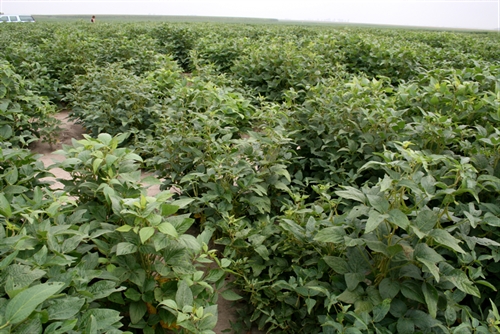27 May 2015. A patent for a genetic sequence derived from soybeans, but applicable through engineering to a range of plants, was granted to Ceres Inc., an agricultural biotechnology company in Thousand Oaks, California. The U.S. Patent and Trademark Office granted patent number 9,024,004, Sequence-determined DNA fragments encoding acetohydroxyacid synthase proteins, on 5 May 2015 to three inventors and assigned to Ceres Inc.
Ceres Inc. develops engineered seeds and plant traits for food crops, biochemicals, and biofuel feedstocks. The company says its technology is based on genomic sequencing, and branches out from there to molecular markers for plant breeding and engineered solutions that add desired traits to plant genomes.
The patent applies to a genetic sequence in plants isolated by Ceres that codes key proteins known as acetohydroxyacid synthase proteins. These proteins are found in a number of food crops and oil plants including soybeans, corn, wheat, and rice, as well as Arabidopsis model plant species. Because this genetic pathway is found in plants and not in humans or animals, it is a target for herbicide development.
Ceres believes the technology can be applied to other biosynthesis processes, and the patent covers further applications for developing new plant products with traits needed to withstand climatic changes, such as increased drought resistance. The company says it plans to license the technology to seed companies, including exclusive licenses that apply the patent to specific plant species.
Because the genetic sequence technology was derived from soybeans, the company believes first applications will be with this crop. Soybeans are the world’s largest source of animal protein feed and the second largest source of vegetable oil, with the U.S. being the world’s largest soybean producer. Worldwide growers plant some 111.3 million hectares (275 million acres) of soybeans, according to the U.N. Food and Agriculture Organization.
The patent, however, does not restrict the technology’s coverage to soybeans. The patent’s language applies the technology to plant species in general, with references to soybeans given only as examples, usually with other plant species.
Read more:
- Plant Science Biotech Gets Genome Editing Technology
- University Breeds Genome-Edited Pigs
- Biotech, McGill Univ Partner on Soil Enhancement Microbes
- Genes Identified to Boost Vitamin A in Corn
- Coffee Genome Sequenced, Caffeine Enzymes Analyzed
* * *


 RSS - Posts
RSS - Posts
You must be logged in to post a comment.